Risk Management in Healthcare: Interview Report and Analysis
VerifiedAdded on 2022/08/13
|7
|1484
|30
Report
AI Summary
This report presents an analysis of an interview conducted with the Risk Safety Manager of the Brooklyn Adult Care Center, focusing on their organizational risk management program. The interview reveals the center's risk management strategies, including a program that assesses operational risks and implements reduction measures, along with a manual for managing emergencies and crises. The facility emphasizes staff training to meet patient care expectations and addresses legal, professional, and ethical issues through an integrated educational program, including standards to prevent negligence and malpractice. The report highlights the implementation of preventive measures to minimize risks to patients and caregivers, along with policies addressing emergency triage in high-risk areas. Challenges such as patient health conditions, lack of knowledge, and limited staff training are discussed. The center employs yearly audits and quarterly surveys to monitor program effectiveness and compliance. The interview concludes that while the center has an effective risk management program, there is scope for improvement in care quality, particularly in communication and stakeholder engagement. Recommendations include small-scale implementation of improvements and continuous revision of the risk management program to align with industry changes and maintain its reputation. The report emphasizes the need for the organization to maintain strict compliance to distinguish itself from other adult healthcare centers.
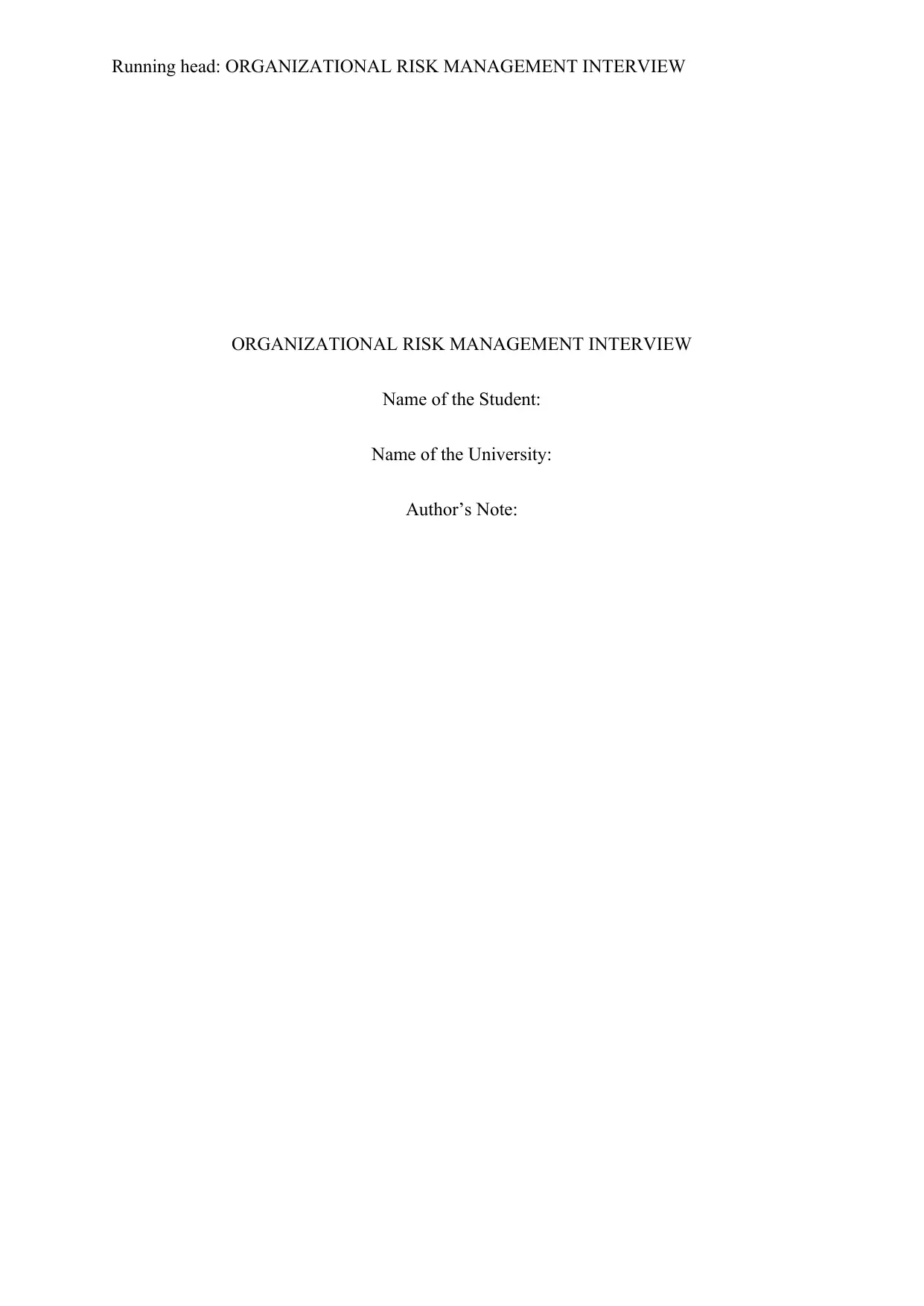
Running head: ORGANIZATIONAL RISK MANAGEMENT INTERVIEW
ORGANIZATIONAL RISK MANAGEMENT INTERVIEW
Name of the Student:
Name of the University:
Author’s Note:
ORGANIZATIONAL RISK MANAGEMENT INTERVIEW
Name of the Student:
Name of the University:
Author’s Note:
Paraphrase This Document
Need a fresh take? Get an instant paraphrase of this document with our AI Paraphraser
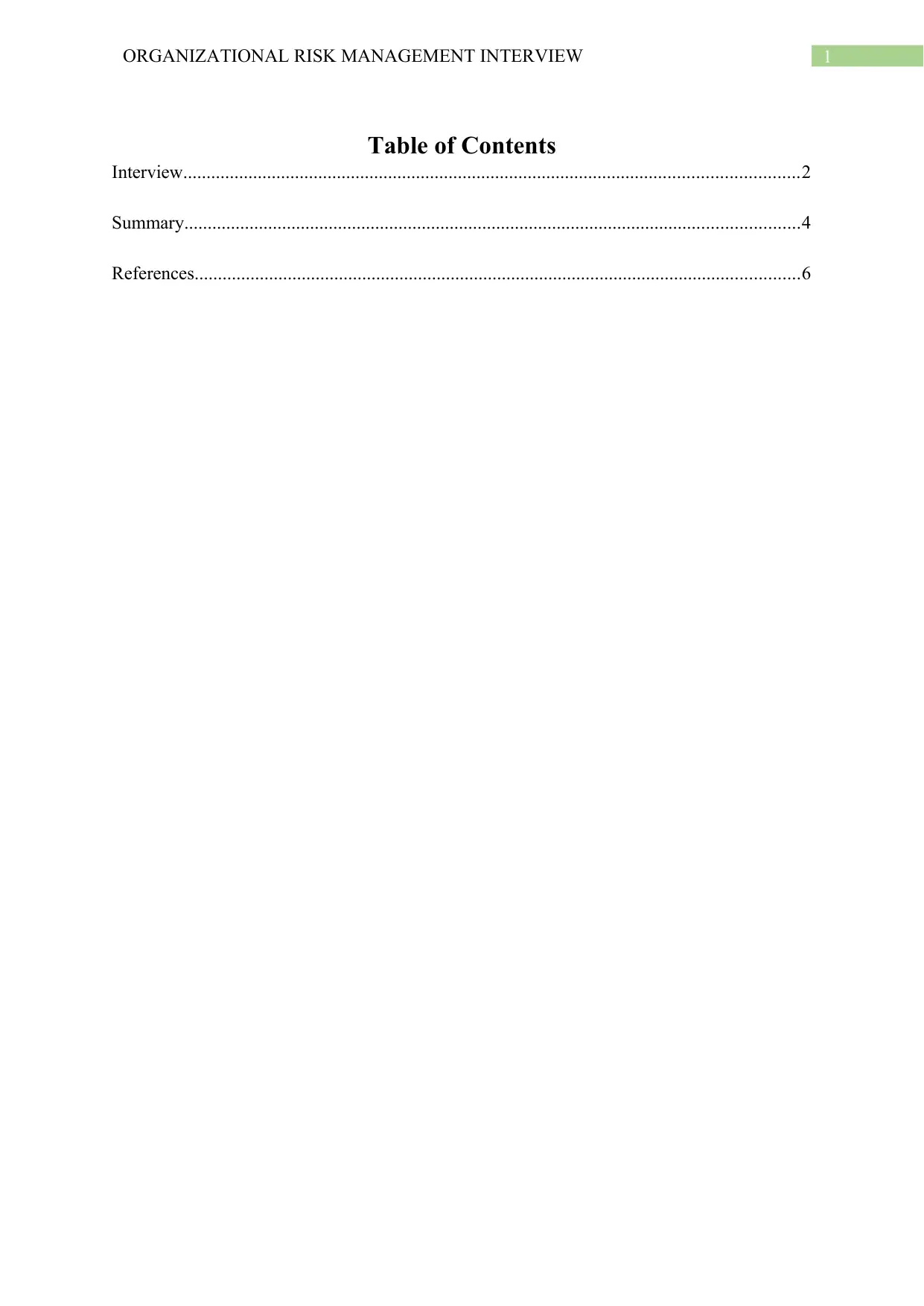
1ORGANIZATIONAL RISK MANAGEMENT INTERVIEW
Table of Contents
Interview....................................................................................................................................2
Summary....................................................................................................................................4
References..................................................................................................................................6
Table of Contents
Interview....................................................................................................................................2
Summary....................................................................................................................................4
References..................................................................................................................................6
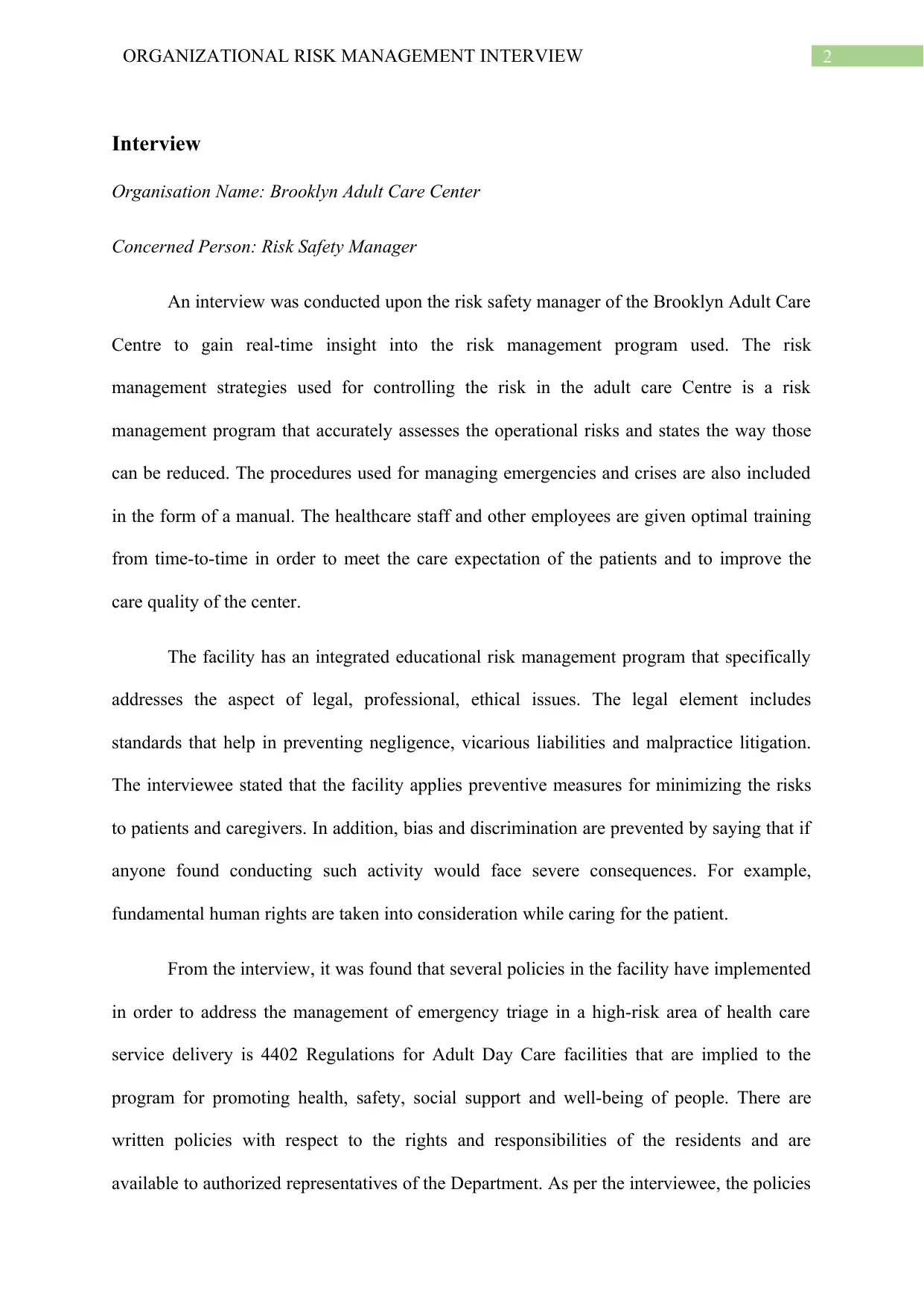
2ORGANIZATIONAL RISK MANAGEMENT INTERVIEW
Interview
Organisation Name: Brooklyn Adult Care Center
Concerned Person: Risk Safety Manager
An interview was conducted upon the risk safety manager of the Brooklyn Adult Care
Centre to gain real-time insight into the risk management program used. The risk
management strategies used for controlling the risk in the adult care Centre is a risk
management program that accurately assesses the operational risks and states the way those
can be reduced. The procedures used for managing emergencies and crises are also included
in the form of a manual. The healthcare staff and other employees are given optimal training
from time-to-time in order to meet the care expectation of the patients and to improve the
care quality of the center.
The facility has an integrated educational risk management program that specifically
addresses the aspect of legal, professional, ethical issues. The legal element includes
standards that help in preventing negligence, vicarious liabilities and malpractice litigation.
The interviewee stated that the facility applies preventive measures for minimizing the risks
to patients and caregivers. In addition, bias and discrimination are prevented by saying that if
anyone found conducting such activity would face severe consequences. For example,
fundamental human rights are taken into consideration while caring for the patient.
From the interview, it was found that several policies in the facility have implemented
in order to address the management of emergency triage in a high-risk area of health care
service delivery is 4402 Regulations for Adult Day Care facilities that are implied to the
program for promoting health, safety, social support and well-being of people. There are
written policies with respect to the rights and responsibilities of the residents and are
available to authorized representatives of the Department. As per the interviewee, the policies
Interview
Organisation Name: Brooklyn Adult Care Center
Concerned Person: Risk Safety Manager
An interview was conducted upon the risk safety manager of the Brooklyn Adult Care
Centre to gain real-time insight into the risk management program used. The risk
management strategies used for controlling the risk in the adult care Centre is a risk
management program that accurately assesses the operational risks and states the way those
can be reduced. The procedures used for managing emergencies and crises are also included
in the form of a manual. The healthcare staff and other employees are given optimal training
from time-to-time in order to meet the care expectation of the patients and to improve the
care quality of the center.
The facility has an integrated educational risk management program that specifically
addresses the aspect of legal, professional, ethical issues. The legal element includes
standards that help in preventing negligence, vicarious liabilities and malpractice litigation.
The interviewee stated that the facility applies preventive measures for minimizing the risks
to patients and caregivers. In addition, bias and discrimination are prevented by saying that if
anyone found conducting such activity would face severe consequences. For example,
fundamental human rights are taken into consideration while caring for the patient.
From the interview, it was found that several policies in the facility have implemented
in order to address the management of emergency triage in a high-risk area of health care
service delivery is 4402 Regulations for Adult Day Care facilities that are implied to the
program for promoting health, safety, social support and well-being of people. There are
written policies with respect to the rights and responsibilities of the residents and are
available to authorized representatives of the Department. As per the interviewee, the policies
⊘ This is a preview!⊘
Do you want full access?
Subscribe today to unlock all pages.

Trusted by 1+ million students worldwide
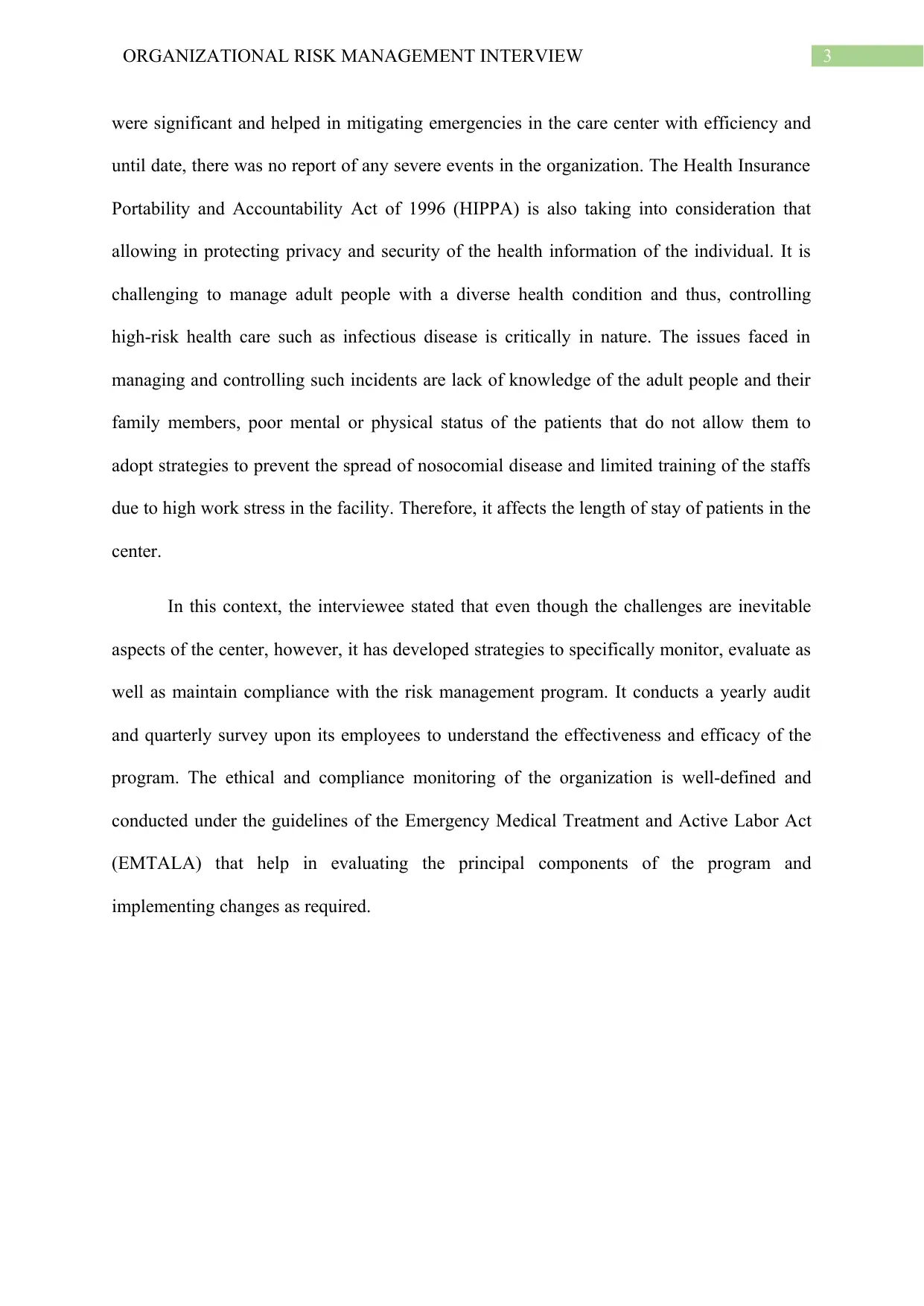
3ORGANIZATIONAL RISK MANAGEMENT INTERVIEW
were significant and helped in mitigating emergencies in the care center with efficiency and
until date, there was no report of any severe events in the organization. The Health Insurance
Portability and Accountability Act of 1996 (HIPPA) is also taking into consideration that
allowing in protecting privacy and security of the health information of the individual. It is
challenging to manage adult people with a diverse health condition and thus, controlling
high-risk health care such as infectious disease is critically in nature. The issues faced in
managing and controlling such incidents are lack of knowledge of the adult people and their
family members, poor mental or physical status of the patients that do not allow them to
adopt strategies to prevent the spread of nosocomial disease and limited training of the staffs
due to high work stress in the facility. Therefore, it affects the length of stay of patients in the
center.
In this context, the interviewee stated that even though the challenges are inevitable
aspects of the center, however, it has developed strategies to specifically monitor, evaluate as
well as maintain compliance with the risk management program. It conducts a yearly audit
and quarterly survey upon its employees to understand the effectiveness and efficacy of the
program. The ethical and compliance monitoring of the organization is well-defined and
conducted under the guidelines of the Emergency Medical Treatment and Active Labor Act
(EMTALA) that help in evaluating the principal components of the program and
implementing changes as required.
were significant and helped in mitigating emergencies in the care center with efficiency and
until date, there was no report of any severe events in the organization. The Health Insurance
Portability and Accountability Act of 1996 (HIPPA) is also taking into consideration that
allowing in protecting privacy and security of the health information of the individual. It is
challenging to manage adult people with a diverse health condition and thus, controlling
high-risk health care such as infectious disease is critically in nature. The issues faced in
managing and controlling such incidents are lack of knowledge of the adult people and their
family members, poor mental or physical status of the patients that do not allow them to
adopt strategies to prevent the spread of nosocomial disease and limited training of the staffs
due to high work stress in the facility. Therefore, it affects the length of stay of patients in the
center.
In this context, the interviewee stated that even though the challenges are inevitable
aspects of the center, however, it has developed strategies to specifically monitor, evaluate as
well as maintain compliance with the risk management program. It conducts a yearly audit
and quarterly survey upon its employees to understand the effectiveness and efficacy of the
program. The ethical and compliance monitoring of the organization is well-defined and
conducted under the guidelines of the Emergency Medical Treatment and Active Labor Act
(EMTALA) that help in evaluating the principal components of the program and
implementing changes as required.
Paraphrase This Document
Need a fresh take? Get an instant paraphrase of this document with our AI Paraphraser
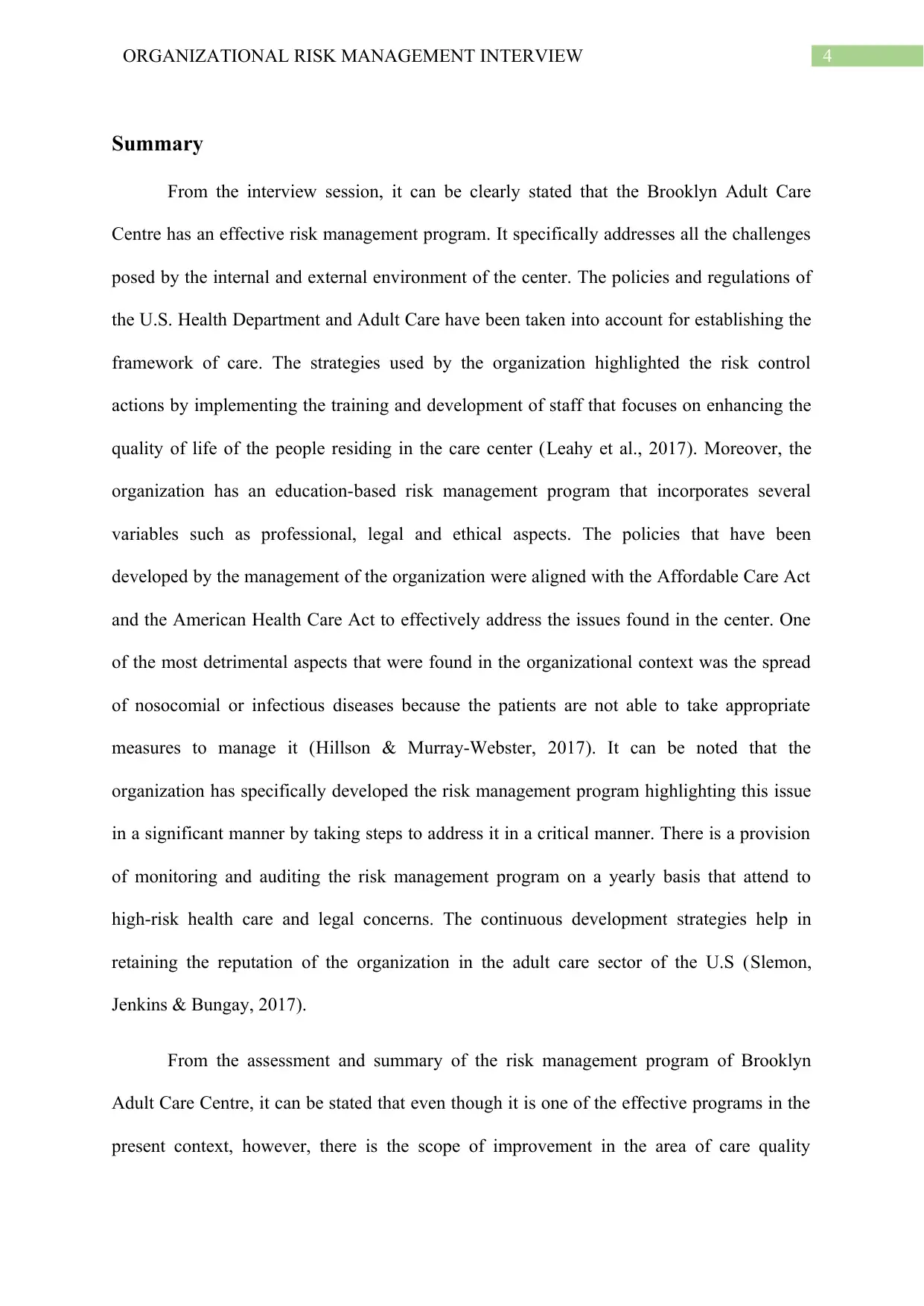
4ORGANIZATIONAL RISK MANAGEMENT INTERVIEW
Summary
From the interview session, it can be clearly stated that the Brooklyn Adult Care
Centre has an effective risk management program. It specifically addresses all the challenges
posed by the internal and external environment of the center. The policies and regulations of
the U.S. Health Department and Adult Care have been taken into account for establishing the
framework of care. The strategies used by the organization highlighted the risk control
actions by implementing the training and development of staff that focuses on enhancing the
quality of life of the people residing in the care center (Leahy et al., 2017). Moreover, the
organization has an education-based risk management program that incorporates several
variables such as professional, legal and ethical aspects. The policies that have been
developed by the management of the organization were aligned with the Affordable Care Act
and the American Health Care Act to effectively address the issues found in the center. One
of the most detrimental aspects that were found in the organizational context was the spread
of nosocomial or infectious diseases because the patients are not able to take appropriate
measures to manage it (Hillson & Murray-Webster, 2017). It can be noted that the
organization has specifically developed the risk management program highlighting this issue
in a significant manner by taking steps to address it in a critical manner. There is a provision
of monitoring and auditing the risk management program on a yearly basis that attend to
high-risk health care and legal concerns. The continuous development strategies help in
retaining the reputation of the organization in the adult care sector of the U.S (Slemon,
Jenkins & Bungay, 2017).
From the assessment and summary of the risk management program of Brooklyn
Adult Care Centre, it can be stated that even though it is one of the effective programs in the
present context, however, there is the scope of improvement in the area of care quality
Summary
From the interview session, it can be clearly stated that the Brooklyn Adult Care
Centre has an effective risk management program. It specifically addresses all the challenges
posed by the internal and external environment of the center. The policies and regulations of
the U.S. Health Department and Adult Care have been taken into account for establishing the
framework of care. The strategies used by the organization highlighted the risk control
actions by implementing the training and development of staff that focuses on enhancing the
quality of life of the people residing in the care center (Leahy et al., 2017). Moreover, the
organization has an education-based risk management program that incorporates several
variables such as professional, legal and ethical aspects. The policies that have been
developed by the management of the organization were aligned with the Affordable Care Act
and the American Health Care Act to effectively address the issues found in the center. One
of the most detrimental aspects that were found in the organizational context was the spread
of nosocomial or infectious diseases because the patients are not able to take appropriate
measures to manage it (Hillson & Murray-Webster, 2017). It can be noted that the
organization has specifically developed the risk management program highlighting this issue
in a significant manner by taking steps to address it in a critical manner. There is a provision
of monitoring and auditing the risk management program on a yearly basis that attend to
high-risk health care and legal concerns. The continuous development strategies help in
retaining the reputation of the organization in the adult care sector of the U.S (Slemon,
Jenkins & Bungay, 2017).
From the assessment and summary of the risk management program of Brooklyn
Adult Care Centre, it can be stated that even though it is one of the effective programs in the
present context, however, there is the scope of improvement in the area of care quality
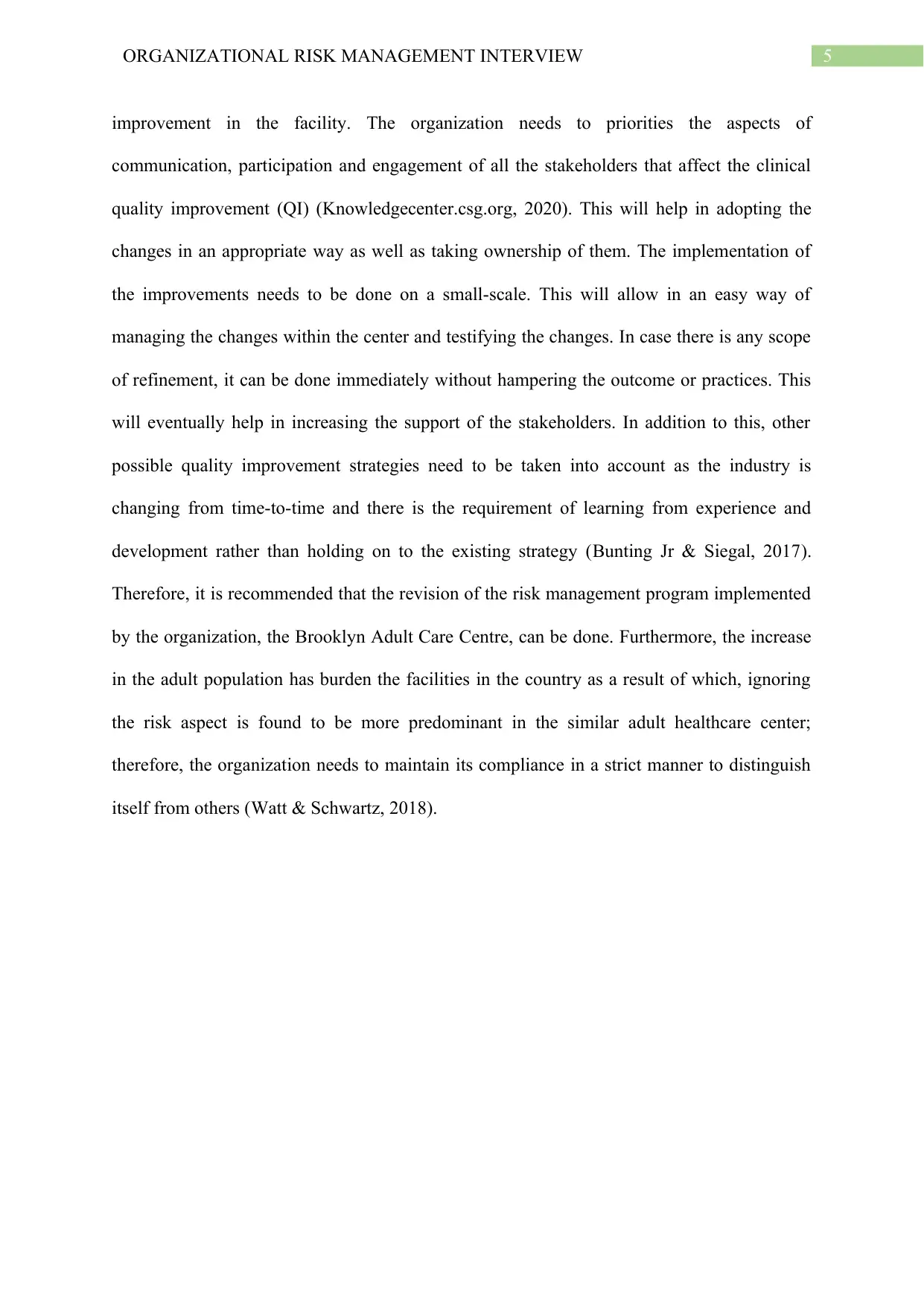
5ORGANIZATIONAL RISK MANAGEMENT INTERVIEW
improvement in the facility. The organization needs to priorities the aspects of
communication, participation and engagement of all the stakeholders that affect the clinical
quality improvement (QI) (Knowledgecenter.csg.org, 2020). This will help in adopting the
changes in an appropriate way as well as taking ownership of them. The implementation of
the improvements needs to be done on a small-scale. This will allow in an easy way of
managing the changes within the center and testifying the changes. In case there is any scope
of refinement, it can be done immediately without hampering the outcome or practices. This
will eventually help in increasing the support of the stakeholders. In addition to this, other
possible quality improvement strategies need to be taken into account as the industry is
changing from time-to-time and there is the requirement of learning from experience and
development rather than holding on to the existing strategy (Bunting Jr & Siegal, 2017).
Therefore, it is recommended that the revision of the risk management program implemented
by the organization, the Brooklyn Adult Care Centre, can be done. Furthermore, the increase
in the adult population has burden the facilities in the country as a result of which, ignoring
the risk aspect is found to be more predominant in the similar adult healthcare center;
therefore, the organization needs to maintain its compliance in a strict manner to distinguish
itself from others (Watt & Schwartz, 2018).
improvement in the facility. The organization needs to priorities the aspects of
communication, participation and engagement of all the stakeholders that affect the clinical
quality improvement (QI) (Knowledgecenter.csg.org, 2020). This will help in adopting the
changes in an appropriate way as well as taking ownership of them. The implementation of
the improvements needs to be done on a small-scale. This will allow in an easy way of
managing the changes within the center and testifying the changes. In case there is any scope
of refinement, it can be done immediately without hampering the outcome or practices. This
will eventually help in increasing the support of the stakeholders. In addition to this, other
possible quality improvement strategies need to be taken into account as the industry is
changing from time-to-time and there is the requirement of learning from experience and
development rather than holding on to the existing strategy (Bunting Jr & Siegal, 2017).
Therefore, it is recommended that the revision of the risk management program implemented
by the organization, the Brooklyn Adult Care Centre, can be done. Furthermore, the increase
in the adult population has burden the facilities in the country as a result of which, ignoring
the risk aspect is found to be more predominant in the similar adult healthcare center;
therefore, the organization needs to maintain its compliance in a strict manner to distinguish
itself from others (Watt & Schwartz, 2018).
⊘ This is a preview!⊘
Do you want full access?
Subscribe today to unlock all pages.

Trusted by 1+ million students worldwide
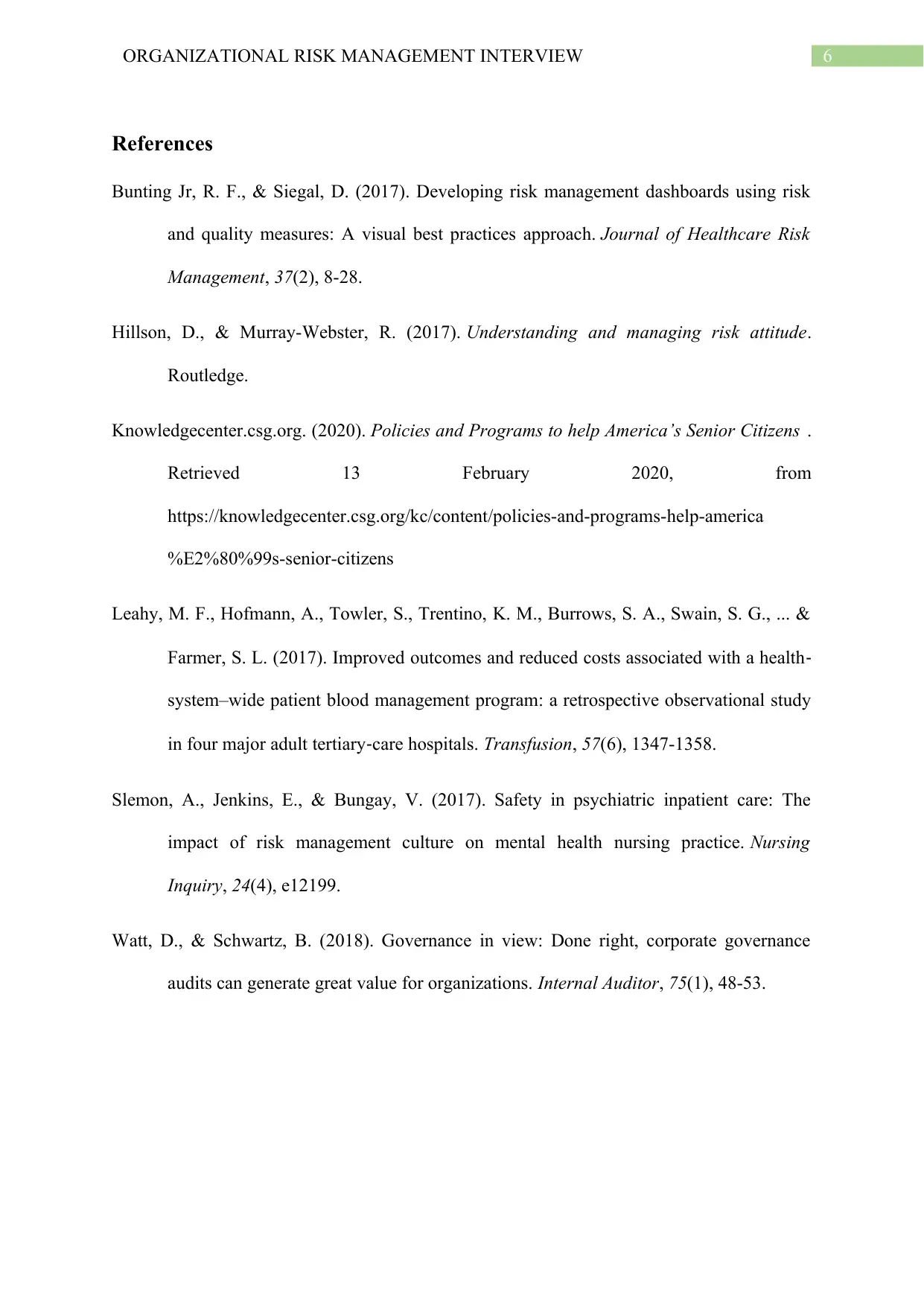
6ORGANIZATIONAL RISK MANAGEMENT INTERVIEW
References
Bunting Jr, R. F., & Siegal, D. (2017). Developing risk management dashboards using risk
and quality measures: A visual best practices approach. Journal of Healthcare Risk
Management, 37(2), 8-28.
Hillson, D., & Murray-Webster, R. (2017). Understanding and managing risk attitude.
Routledge.
Knowledgecenter.csg.org. (2020). Policies and Programs to help America’s Senior Citizens .
Retrieved 13 February 2020, from
https://knowledgecenter.csg.org/kc/content/policies-and-programs-help-america
%E2%80%99s-senior-citizens
Leahy, M. F., Hofmann, A., Towler, S., Trentino, K. M., Burrows, S. A., Swain, S. G., ... &
Farmer, S. L. (2017). Improved outcomes and reduced costs associated with a health‐
system–wide patient blood management program: a retrospective observational study
in four major adult tertiary‐care hospitals. Transfusion, 57(6), 1347-1358.
Slemon, A., Jenkins, E., & Bungay, V. (2017). Safety in psychiatric inpatient care: The
impact of risk management culture on mental health nursing practice. Nursing
Inquiry, 24(4), e12199.
Watt, D., & Schwartz, B. (2018). Governance in view: Done right, corporate governance
audits can generate great value for organizations. Internal Auditor, 75(1), 48-53.
References
Bunting Jr, R. F., & Siegal, D. (2017). Developing risk management dashboards using risk
and quality measures: A visual best practices approach. Journal of Healthcare Risk
Management, 37(2), 8-28.
Hillson, D., & Murray-Webster, R. (2017). Understanding and managing risk attitude.
Routledge.
Knowledgecenter.csg.org. (2020). Policies and Programs to help America’s Senior Citizens .
Retrieved 13 February 2020, from
https://knowledgecenter.csg.org/kc/content/policies-and-programs-help-america
%E2%80%99s-senior-citizens
Leahy, M. F., Hofmann, A., Towler, S., Trentino, K. M., Burrows, S. A., Swain, S. G., ... &
Farmer, S. L. (2017). Improved outcomes and reduced costs associated with a health‐
system–wide patient blood management program: a retrospective observational study
in four major adult tertiary‐care hospitals. Transfusion, 57(6), 1347-1358.
Slemon, A., Jenkins, E., & Bungay, V. (2017). Safety in psychiatric inpatient care: The
impact of risk management culture on mental health nursing practice. Nursing
Inquiry, 24(4), e12199.
Watt, D., & Schwartz, B. (2018). Governance in view: Done right, corporate governance
audits can generate great value for organizations. Internal Auditor, 75(1), 48-53.
1 out of 7
Related Documents
Your All-in-One AI-Powered Toolkit for Academic Success.
+13062052269
info@desklib.com
Available 24*7 on WhatsApp / Email
![[object Object]](/_next/static/media/star-bottom.7253800d.svg)
Unlock your academic potential
Copyright © 2020–2025 A2Z Services. All Rights Reserved. Developed and managed by ZUCOL.





